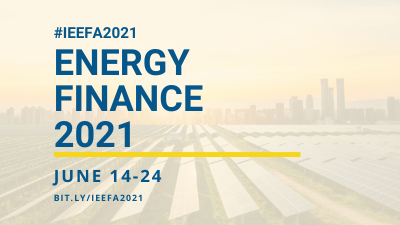IEEFA Energy Finance 2021: Week two in review

June 25, 2021 (IEEFA) ⎼ Energy experts, financial analysts, legal specialists, activists and journalists gathered online this week for the second and final week of IEEFA’s 2021 Energy Finance conference. Held remotely due to travel restrictions related to the coronavirus pandemic, experts highlighted the latest trends in the global energy transition. Recordings of the sessions are posted on IEEFA’s 2021 conference page.
Petrochemicals: Overcapacity and Community Opposition Challenge the Industry’s Growth Projections
June 21, 2021
IEEFA’s Tom Sanzillo and Suzanne Mattei joined Sharon Lavigne, director of RISE St. James, to discuss the oil industry’s bet on profit growth in plastics and petrochemicals. While market research suggests the sector is overbuilding, leading to weaker profits, the industry is doubling down on potential growth scenarios both in the U.S. and internationally.
Lavigne underscored the urgent need to push back against the Formosa plastics plant project in St. James Parish, La., due to its harmful ecological and health impacts. After a slew of lawsuits, the U.S. Army Corps of Engineers is re-evaluating the plan, bringing the project to a standstill.
Sanzillo stressed how the oil industry is relying on its plastics and petrochemicals sectors to buoy its struggling financials. However, he noted that even though prices and demand are rebounding as the pandemic subsides in some markets, the short-term spike will come back down as the global economy recovers.
From a political and ecological perspective, Sanzillo suggested that bans on single-use plastics are indeed having an effect on demand. But the measures ultimately won’t be a danger to the plastics industry because of steady demand for medical and other purposes.
Renewable Energy: Lessons on Grid Integration and Benefits for Communities
June 22, 2021
IEEFA’s Johanna Bowyer and Dennis Wamsted joined energy consultant Gabrielle Kuiper and East Bay Community Energy’s Marie Fontenot to consider what the U.S. could learn from other countries, such as Australia, about renewable energy integration.
In South Australia, Bowyer explained how the regional government aims to achieve 500% grid demand by 2050 in a push to go beyond 100% renewables, driving job growth.
Kuiper outlined the integration of rooftop solar into South Australia’s power grid. She demonstrated how only relatively small technological and management changes need to be made to cope with high volumes of rooftop solar. Only 1% of regulated network revenue is used to manage existing levels.
Fontenot explored renewable energy’s integration in California. East Bay Community Energy has set a goal of 100% emissions-free energy by 2030, following the state’s mandate that 60% of retail energy be met with renewable resources by the same year.
Storage: The Key to the Grid of the Future
June 23, 2021
IEEFA’s Arjun Flora joined Alexa Capital’s Stephen Prince and JASenergies’ Julia Prochnik to discuss the importance of advancing storage capabilities for the future viability of renewable energy.
Flora argued that storage had made huge inroads but still had a long way to go, and that it has struggled to show predictable revenue streams. This has made investment difficult, even if the technological benefits are already there.
Technology risks, according to Prince, impede wider adoption of energy storage. There need to be more proven solutions that perform as well as projections before capital costs can be brought down for greater market penetration.
In the U.S., one of the biggest obstacles so far has been to get interconnection agreements with local utilities, which can take anywhere between 18-24 months, according to Prince. Once implemented, however, the addition of storage could replace the need for new transmission lines. Regulators, he said, would go along with storage solutions as soon as they were proven to be economically sound.
Markets: Energy Transition is Here. Where are the Investors?
June 24, 2021
IEEFA’s Melissa Brown moderated a discussion between the Sunrise Project’s Tanya Kar and Sustainalytics’ Diederik Timmer about shifting energy financial markets.
Over 150 globally significant financial institutions have divested from coal and other fossil fuels while investors look to integrate climate risk and the energy transition into mainstream portfolios.
The biggest driver for growth in environmental, social and governance (ESG) investing in the U.S. is the individual, said Timmer. Customers are asking their advisors to help them invest in line with their values and concerns about climate impact.
However, asset managers in the U.S. have been slow to develop ESG strategies, often putting them into alternative sections of portfolios. Timmer suggested that asset managers, who operate globally, are responding to ESG demands from Europe, Australia and Japan, among other locations, to create products for the U.S. market.
Kar argued that the Big 3 (BlackRock, Vanguard and Fidelity), who account for $20 trillion in assets, have failed to protect the global economy from arguably the biggest threat of systemic risk: climate change.
To view the session recordings, go to our Energy Finance 2021 conference page.
Muhamed Sulejmanagic ([email protected]) is IEEFA’s media relations manager.
About IEEFA
The Institute for Energy Economics and Financial Analysis (IEEFA) examines issues related to energy markets, trends and policies. The Institute’s mission is to accelerate the transition to a diverse, sustainable and profitable energy economy.










